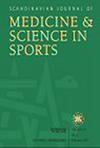最大等速收缩时疲劳运动对股二头肌肌束行为的影响。
IF 3.8
2区 医学
Q1 SPORT SCIENCES
引用次数: 0
摘要
本研究考察了疲劳、非损伤性运动对股二头肌长头(BFlh)肌束劳损的急性影响,以及在同心收缩和偏心收缩时长、短肌肉长度的旋转。对18例(8例女性)无右腿筋拉伤史的健康成人进行BFlh束长(Lf)、束角(FA)和肌肉厚度(MT)的定量分析。使用两个连续排列的超声设备评估BFlh图像,同时在疲劳运动前后以180°/s的速度进行最大同心和偏心等速膝关节屈曲。将超声视频导出并编辑成一个单一的、同步的视频,并通过10°-80°(0°=全膝关节伸展)的运动范围分析三个肌束。测量并比较长(60°-80°膝关节角)和短(10°-30°)肌肉长度和整个膝关节屈曲范围内的Lf、FA和MT的变化(Δ)。在偏心收缩时,较长的肌肉长度观察到较大的ΔLf (p < 0.001),而在同心收缩时,较短的肌肉长度观察到较大的ΔLf (p < 0.001)。在两种收缩模式下,疲劳运动后平均BFlh Lf显著延长(p < 0.001)。在长肌肉长度和偏心收缩时ΔFA更大(p < 0.05),在全ROM时ΔFA更大(p < 0.001)。在ΔLf, ΔFA, ΔMT或肌肉齿轮上没有发现明显的疲劳影响。疲劳运动后更大的平均肌束长度和更长的肌肉长度在偏心收缩时更大的ΔLf和ΔFA可能为疲劳运动中偏心收缩时BFlh拉伤提供了机制。本文章由计算机程序翻译,如有差异,请以英文原文为准。
The Effect of Fatiguing Exercise on Biceps Femoris Fascicle Behaviors During Maximal Isokinetic Contractions.
The present study examined the acute effects of fatiguing, non-damaging exercise on biceps femoris long head (BFlh) fascicle strain and rotation at long and short muscle lengths during concentric versus eccentric contractions. BFlh fascicle length (Lf), fascicle angle (FA), and muscle thickness (MT) were quantified in 18 (8 women) healthy adults without a history of right hamstring strain injury. BFlh images were assessed using two serially aligned ultrasound devices whilst maximal concentric and eccentric isokinetic knee flexions were performed at 180°/s before and after fatiguing exercise. Ultrasound videos were exported and edited to create a single, synchronized video, and three fascicles were analyzed through the range of motion 10°-80° (0° = full knee extension). Changes (Δ) in Lf, FA, and MT at long (60°-80° knee angle) and short (10°-30°) muscle lengths and across the full knee flexion range were measured and compared. Greater ΔLf was observed at long muscle lengths during eccentric contractions (p < 0.001) and at short muscle lengths during concentric contractions (p < 0.001). Average BFlh Lf was significantly longer (p < 0.001) after fatiguing exercise in both contraction modes. ΔFA was greater (p < 0.05) at long muscle length and during eccentric contractions, and ΔFA over the full ROM was greater in eccentric contractions (p < 0.001). No significant effect of fatigue was detected on ΔLf, ΔFA, ΔMT, or muscle gear. The greater mean fascicle length after fatiguing exercise combined with greater ΔLf and ΔFA at longer muscle lengths during eccentric contractions might provide a mechanism for BFlh strain injury during eccentric contractions in fatiguing sports.
求助全文
通过发布文献求助,成功后即可免费获取论文全文。
去求助
来源期刊
CiteScore
7.90
自引率
4.90%
发文量
162
审稿时长
3 months
期刊介绍:
The Scandinavian Journal of Medicine & Science in Sports is a multidisciplinary journal published 12 times per year under the auspices of the Scandinavian Foundation of Medicine and Science in Sports.
It aims to publish high quality and impactful articles in the fields of orthopaedics, rehabilitation and sports medicine, exercise physiology and biochemistry, biomechanics and motor control, health and disease relating to sport, exercise and physical activity, as well as on the social and behavioural aspects of sport and exercise.

 求助内容:
求助内容: 应助结果提醒方式:
应助结果提醒方式:


